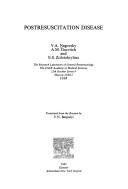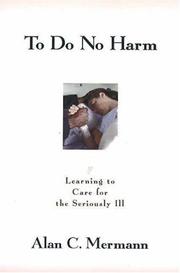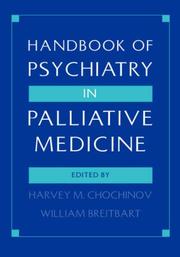| Listing 1 - 10 of 128 | << page >> |
Sort by
|

ISBN: 0444804889 Year: 1983 Publisher: Amsterdam Elsevier
Abstract | Keywords | Export | Availability | Bookmark
 Loading...
Loading...Choose an application
- Reference Manager
- EndNote
- RefWorks (Direct export to RefWorks)

ISBN: 1573926663 1573926671 Year: 1999 Publisher: Amherst Prometheus Books
Abstract | Keywords | Export | Availability | Bookmark
 Loading...
Loading...Choose an application
- Reference Manager
- EndNote
- RefWorks (Direct export to RefWorks)
"To Do No Harm is a study of the ways people experience serious and life-threatening illnesses, the types of suffering they endure, and how we can come to understand their lives. Alan C. Mermann describes a course at the Yale School of Medicine that uses patients as teachers for students, helping them learn the impact of disease upon the whole person. He covers suffering in body, mind, and spirit. The book also discusses the hopes and means for a fully realized life for the professional healthcare provider through compassionate care of the sick."--Jacket.
Critically ill --- Terminal care --- Care
Book
ISBN: 1107777283 1107779766 1139342452 Year: 2014 Publisher: Cambridge : Cambridge University Press,
Abstract | Keywords | Export | Availability | Bookmark
 Loading...
Loading...Choose an application
- Reference Manager
- EndNote
- RefWorks (Direct export to RefWorks)
The association between poor nutrition and disease is well established. Integrating nutritional sciences into clinical practice offers a valuable tool to improve patient care and prognosis, particularly within the critical care environment where nutrition is often overlooked. However, optimizing nutritional support offers a safe and simple adjunct to more expensive and technologically challenging treatments for these complex patients. This volume provides comprehensive guidelines for the nutritional support of critically ill patients and is valuable reading for doctors, nurses, dieticians and practitioners working within the critical care environment. It begins by discussing nutritional physiology and patient assessment, providing an essential foundation for planning and managing the dietary requirements of critically ill patients. Internationally-recognized authors present evidence-based guidelines for managing various groups, including surgical patients, patients with burns, and patients with renal failure. The implications of enteral vs. parenteral nutrition, timing of nutritional support, therapeutic strategies, and management of complications are discussed.
Diet therapy. --- Critically ill --- Nutrition.
Book
ISBN: 291578938X 9782915789386 Year: 2008 Publisher: Paris: Campagne première,
Abstract | Keywords | Export | Availability | Bookmark
 Loading...
Loading...Choose an application
- Reference Manager
- EndNote
- RefWorks (Direct export to RefWorks)
Cet ouvrage témoigne d'une clinique auprès de patients qui autrefois ne relevaient pas de la psychanalyse mais qui, aujourd'hui, s'adressent à elle pour comprendre l'origine de leur souffrance : toxicomanes, suicidants, sidéens, sujets présentant des troubles somatiques graves ou invalidants, voire à la limite d'une décompensation psychotique. L'extrême est envisagé ici tant du côté du patient que du côté du praticien qui doit toujours réinventer le cadre de la cure à la faveur des moments de désarroi qu'il rencontre. À travers plusieurs cas cliniques, l'auteur pose la question de la finalité du travail de la cure analytique et des processus opératoires en situation extrême. François Pommier est psychiatre, psychanalyste, professeur de psychologie clinique à l'université de Rouen et directeur de recherche associé à l'université René Descartes-Paris 5, praticien attaché à l'hôpital Saint-Antoine à Paris. Il est l'auteur de La psychanalyse à l'épreuve du sida, paru aux éditions Aubier-Flammarion en 1996.
Psychopathologie --- Psychoanalysis --- Critically ill --- Catastrophic illness
Book
ISBN: 0874340896 Year: 1987 Publisher: Springhouse Springhouse
Abstract | Keywords | Export | Availability | Bookmark
 Loading...
Loading...Choose an application
- Reference Manager
- EndNote
- RefWorks (Direct export to RefWorks)
Critically ill --- Intensive care nursing --- Family relationships
Book
ISBN: 1107327172 1107238730 1107335272 1107332788 1107336937 110733361X 1299257577 113910781X Year: 2013 Publisher: Cambridge : Cambridge University Press,
Abstract | Keywords | Export | Availability | Bookmark
 Loading...
Loading...Choose an application
- Reference Manager
- EndNote
- RefWorks (Direct export to RefWorks)
The management of critically ill or injured children has become increasingly specialised; nevertheless, the first point of contact for many sick children remains their nearest hospital. Here, the initial management will usually involve emergency department doctors, anaesthetists and paediatricians. Managing the Critically Ill Child is written by anaesthetists and emergency department physicians who currently have a significant paediatric practice. It provides a straightforward guide for non-paediatricians encountering acutely unwell or injured children. This book helps readers apply their knowledge from adult practice to children, and avoid pitfalls where the approaches in paediatrics differ. Written in a practical, concise format, Managing the Critically Ill Child guides physicians beyond the initial emergency algorithms and is essential reading for physicians and trainees in emergency medicine, anaesthesia and intensive care who may be asked to look after a child.
Pediatric emergencies. --- Critically ill children --- Medical care.
Book
ISBN: 198972549X 9781989725498 Year: 2021 Publisher: Toronto : Pottersfield Press,
Abstract | Keywords | Export | Availability | Bookmark
 Loading...
Loading...Choose an application
- Reference Manager
- EndNote
- RefWorks (Direct export to RefWorks)
This book provides parents and other caregivers with suggestions on how to approach children with the information that their parent is seriously ill. There are many examples of how and what to say to children and teens.
Parent and child. --- Critically ill. --- Parents.

ISBN: 1280760567 9786610760565 0199748780 9780199748785 9781280760563 0195092996 9780195092998 Year: 2000 Publisher: Oxford New York Oxford University Press
Abstract | Keywords | Export | Availability | Bookmark
 Loading...
Loading...Choose an application
- Reference Manager
- EndNote
- RefWorks (Direct export to RefWorks)
Palliative treatment --- Terminal care --- Critically ill --- Psychological aspects. --- Medical care
Book
ISBN: 0806614684 Year: 1975 Publisher: Minneapolis Augsburg Publishing House
Abstract | Keywords | Export | Availability | Bookmark
 Loading...
Loading...Choose an application
- Reference Manager
- EndNote
- RefWorks (Direct export to RefWorks)
Critically ill --- Death --- Terminally ill --- Psychology --- Psychological aspects
Book
Year: 2016 Publisher: Geneva, Switzerland : World Health Organization,
Abstract | Keywords | Export | Availability | Bookmark
 Loading...
Loading...Choose an application
- Reference Manager
- EndNote
- RefWorks (Direct export to RefWorks)
Children admitted to hospital often die within 24 hours of admission. Many of these deaths could be prevented if very sick children are identified soon after their arrival in the health facility, and treatment is started immediately. This can be facilitated by rapid triage for all children presenting to hospital to identify those needing immediate emergency care. The Emergency Triage Assessment and Treatment (ETAT) guidelines provide guidance on the most common emergency conditions in children presenting at the health facility. These include but are not limited to airway obstruction and other breathing problems; circulatory impairment or shock; severely altered CNS function (coma or convulsive seizures); and severe dehydration which require urgent appropriate care to prevent death. The recommendations in this publication complement or update guidance in published WHO ETAT training materials published in 2005 and the 2nd edition Pocket book for hospital care for children published in 2013. This guideline however, does not cover all WHO recommendations on paediatric ETAT. It covers only those identified and prioritized by the WHO guideline development group for update in 2013. Other ETAT recommendations not covered in the current publication will be addressed in future ETAT guideline updates. This updated guideline was prepared by a panel of international experts and informed by systematic reviews of evidence as up to 2015 and makes recommendations on three main areas: 1. when to start and stop oxygen therapy; oxygen flow rates and humidification in severely ill children with emergency signs; 2. which intravenous fluids, at what rate and for how long, should be used in the management of infants and children presenting with impaired circulation or shock; and 3. anticonvulsant medicines for children with acute seizures when intravenous (IV) access is and is not available; second-line anticonvulsant medicines for children with established status epilepticus; pharmacological interventions as prophylaxis to prevent recurrence of febrile seizures in children; and diagnostic tests that should be performed on infants and children presenting with seizures with altered consciousness. This guideline is intended for use in low-resource settings where infants and children are likely to be managed by non-specialists. Their aim is to provide clinical guidance to these health workers on managing infants and children presenting with signs of severe illness.
Pediatric emergency services. --- Critically ill children --- Triage (Medicine) --- Medical care.
| Listing 1 - 10 of 128 | << page >> |
Sort by
|

 Search
Search Feedback
Feedback About UniCat
About UniCat  Help
Help News
News